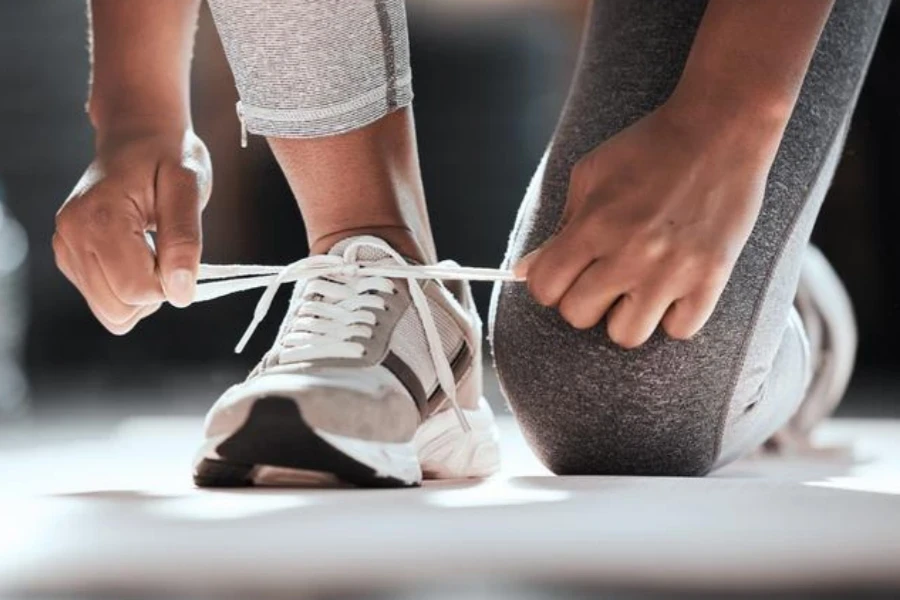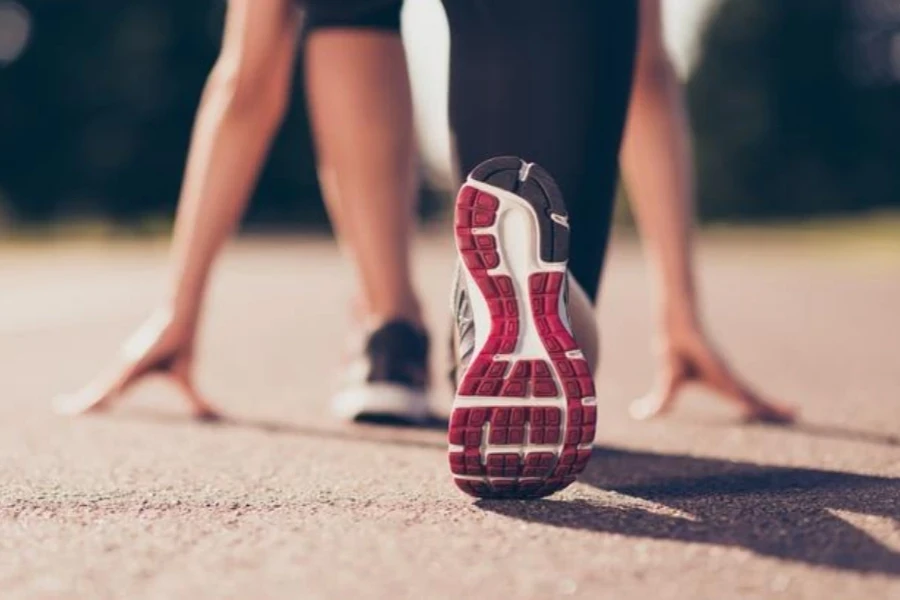Table of Contents
● Introduction
● Understanding the main types and uses of ankle support shoes
● Recent market trends and key insights for 2025
● Factors to consider when selecting ankle support shoes
● Top picks and their features for 2025
● Conclusion
Introduction
Support for your ankles is crucial whether you’re out for a stroll or playing intense sports activities like basketball or soccer. Footwear with ankle support is key in keeping you stable and safe from injuries such as sprains and strains. These shoes help improve your balance and lower the chances of twisting your ankle on uneven paths or when making quick movements. If you’re dealing with ankle problems, wearing these shoes can help ease any pain and keep your feet in the right position for healing properly. Selecting appropriate ankle support shoes protects your joints’ health and boosts your performance by allowing for more assured and stable movements.
Understanding the Main Types and Uses of Ankle Support Shoes

Shoes for athletic performance
For those people who normally engage in sports or other physical activities like running and hiking, having shoes with ankle support is important for staying safe and stable. The shoes are designed with motion control technology as well as sturdy heel support to avoid ankle injuries like twists and any kind of sprains. Normally, they have a midsole that spreads the impact evenly across the user’s foot to lower pressure off the ankles when engaged in intense movements. The finest athletic shoes with ankle support use lightweight and breathable materials in order to provide flexibility without compromising the durability needed for intense physical activities. Moreover, these designs offer the added advantage of promoting alignment of the feet, which can boost performance and minimize fatigue in the long run.
Casual and everyday support shoes
Those seeking balance and comfort in their activities need to consider casual shoes that offer ankle support as the ideal choice to meet their needs effectively and comfortably. These shoes are particularly beneficial for individuals with weak ankles or those recuperating from minor injuries, as they provide the necessary stability without the bulk often found in athletic footwear. They are crafted with softer cushioning for lasting comfort throughout the day and feature supportive elements around the ankle area to ensure a secure fit that minimizes unnecessary movement. Moreover, these shoes are fashioned with designs that suit various occasions, such as casual outings and professional settings. These shoes provide stability and a broader toe box to enhance balance and ensure a comfortable stride. They are especially beneficial for those who spend long hours on their feet.
Shoes for medical or therapeutic use
Orthopedic and therapeutic shoes aim to ease pain and aid in the healing process for people dealing with long-term ankle discomfort or recovering from injuries. These footwear options have ankle support collars and extra cushioning to stabilize the foot and ankle joints. Additionally, they often offer customization, such as removable insoles to accommodate personalized orthotic inserts for individual requirements. Their main focus is improving walking problems and less pressure on muscles, which is crucial for individuals undergoing physical therapy. Therapeutic shoes typically incorporate sturdy materials to provide comfort and stability and are used for prolonged use during recovery.
Recent Market Trends and Key Insights for 2025

Experts value the orthopedic footwear industry, including shoes with ankle support at around US $3.63 billion as of 2022 and is projected to expand to US $9.07 billion by 2032. This surge in market size is primarily attributed to the rising consumer interest in health and fitness-related products, showing a compound annual growth rate of 9.6 % from 2022 to 2032 (Source; Market Research Report, “Global Analysis & Forecast of the Orthopedic Shoes Market, for the period 2022 2032”).
In 2025, the shoe industry is evolving due to the increasing need for shoes that can be worn casually or for sports with ease and versatility while providing ankle support and durability for different activities and surfaces. Manufacturers meet this demand by creating shoes with ankle support features, adaptable soles, and improved cushioning to balance comfort and stability. The rise in this trend reflects a move toward wardrobes that require fewer pairs of shoes while promoting sustainability by using long-lasting and eco-friendly materials. With a focus on practicality and eco-consciousness coming together, the desire for footwear is increasing.
Advancements in ankle support technology continue to shape the footwear industry in 2025 by enhancing cushion support and traction while improving motion control features with cutting-edge materials and biomechanical designs with innovations focused on impact absorption. They are reducing ankle strain while enhancing stability to lower the risk of injuries. New cushion technologies, like better foams and gel inserts, encourage a more natural walking stride, and outsoles featuring multi-direction grip patterns provide stability across various surfaces. In contemporary footwear designs, motion control technology evolves to cater to foot movements more precisely to reduce ankle instability and establish higher benchmarks for performance and safety.
Factors to Consider When Selecting Ankle Support Shoes

Level of ankle support and stability
When choosing ankle support shoes, stability is key. Various options suit different support requirements, from basic ankle protection to high-tech motion control technology. If you have slight instability issues, reinforced collars, and sturdy midsole structures can help align and control your ankles effectively. However, for individuals with ankle problems or prone to injuries, shoes with motion control features that restrict excessive foot movement may be necessary. These shoes support the ankle to reduce the risk of injuries and encourage foot movements while engaging in physical activities.
Activity-specific design
When selecting shoes with ankle support in mind, buyers need to consider the precise activity the shoes will be involved in. For running shoes, focus on flexible options that help propel you forward. Hiking shoes mostly have thicker and robust soles that are good for navigating rugged terrain. Casual shoes must be able to offer comfort, style, and reinforcement for the ankles during everyday wear. The main idea is to select shoes that are not just comfy but also tailored to suit the movements required for various physical activities.
Durability and material quality
The durability of ankle support shoes is largely determined by the quality of the materials used in their construction. Shoes with high-quality uppers, midsoles, and outsoles are more likely to withstand prolonged use, especially in demanding environments. Durable uppers—whether made from leather, synthetic materials, or mesh—are resistant to wear and tear, while robust midsoles provide consistent cushioning and support. Outsoles with sturdy treads offer long-lasting traction, which is essential for maintaining grip and stability. Prioritizing material quality ensures that shoes offer reliable ankle protection over time.
Top Picks and Their Features for 2025

Top-rated shoes for athletic and performance use
In 2025, the latest athletic footwear is pushing boundaries with its cutting-edge ankle support and lightweight construction features for runners, hikers, and sports lovers who seek a balance of stability and flexibility. The enhanced motion control technology is incorporated into these models to keep the feet properly aligned during movements, lowering the chances of ankle strains. Additionally, many top-rated options come equipped with advanced traction systems that make them suitable for diverse terrain types, be it a smooth-running track or a challenging mountain trail. Shoes in this category focus on balancing cushion support and responsiveness to help athletes achieve their best performance while maintaining comfort and protection.
These athletic shoes have the feature of being breathable and designed ergonomically to enhance performance during workouts. They are made with breathable materials that allow air circulation while keeping their structural integrity intact to prevent overheating during intense exercises. The athletic shoes are also crafted with a balanced heel-to-toe drop, encouraging a natural stride that boosts stability. This meticulous design ensures athletes can move confidently, knowing their shoes offer the ankle support and durability required for strenuous activities.
Best shoes for walking and casual support
In 2025, fashion for individuals looking for everyday shoes combines comfort with discreet ankle support that works well together. These styles are crafted for people who spend a lot of time standing and need stability without the bulkiness of sports shoes. The emphasis is placed on using materials that gently support the ankle while providing ample cushion for all-day comfort. Incorporating shock absorption in the heel and arch regions of these designs helps to lower tiredness and lessen strain in the joints with long-term use. Some soles resist slipping and provide a hold on different surfaces. Making them perfect for everyday use.
These casual shoes stand out for their versatility factor as they offer ankle support while boasting a chic look that works well in various settings like the office or casual gatherings. They often feature midsoles that mold to the wearer’s foot shape for a snug and customized fit. This guarantees wearers comfort and subtle protection for the feet and ankles, making them an ideal option for individuals seeking dependable support in their everyday activities.
Specialized shoes for recovery and medical use
Footwear tailored for rehabilitation or medical purposes plays a role in aiding individuals dealing with persistent ankle discomfort or recovering from injuries. There are specialized shoe designs that provide ankle support with reinforced collars and firmer midsoles. These orthopedic shoes in the year 2025 offer remedies for ailments such as plantar fasciitis and sprains by offering improved cushioning and control over movement. Many of these footwear options are customizable to accommodate the insertion of insoles tailored to address specific medical requirements. This customization ensures the foot is correctly aligned for healing and comfort purposes.
By prioritizing durability and comfort in their design, medical-grade shoes aim to aid recovery while allowing individuals to carry out their routines with minimal discomfort. This emphasis on durability and comfort is particularly important in assisting injury rehabilitation efforts as it ensures users can regain their strength while maintaining their ability to move around easily and sustainably.
Conclusion

In 2025, finding the perfect ankle support shoes requires a thorough assessment of features like the level of support provided and the durability of the materials used in their construction. Finding shoes that offer ankle stability and control over motion is crucial to minimize injuries. Additionally, ensuring a comfortable and secure fit is key for wearing them all day without any discomfort. The longevity of the shoes is also important, as using high-quality materials will help extend their lifespan through activities. Choosing the ideal shoe for a specific purpose, such as sports activities, everyday wear, or medical rehabilitation, ensures that individuals receive the best protection and performance customized to their requirements.




